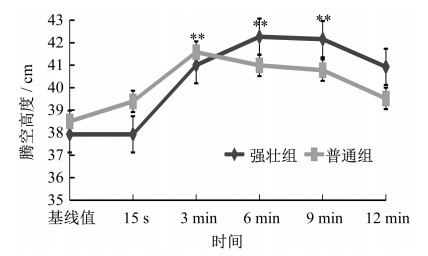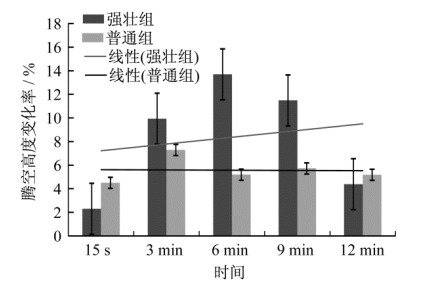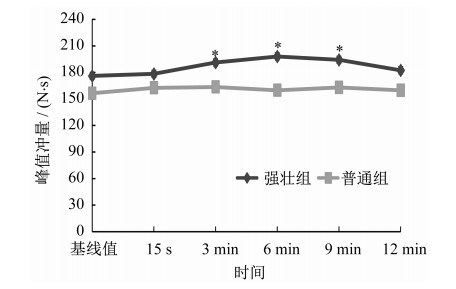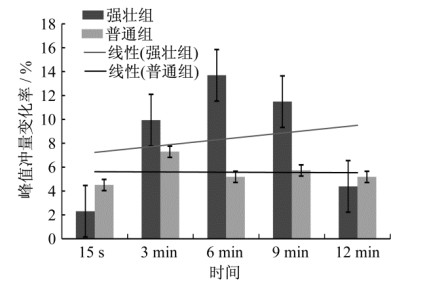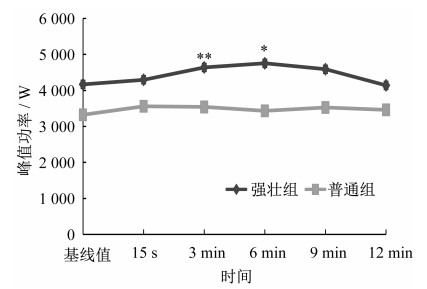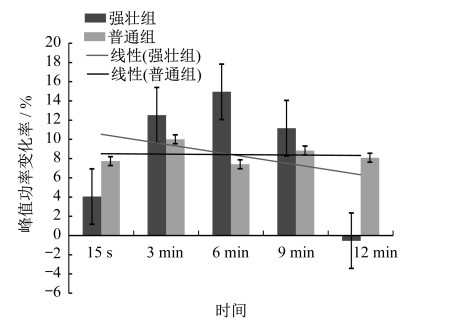Temporal Profile of Post-Activation Potentiation in Athletes with Different Strength Levels
-
摘要:目的 探究不同力量水平运动员激活后增强效应(post-activation potentiation,PAP)的时域特征。方法 PAP诱导练习采用90% 1 RM重复3次杠铃半蹲,使用三维测力台对13名受试者静态半蹲跳前测值和跳后(15 s、3 min、6 min、9 min、12 min)测值进行采集。采用双变量重复测量设计,运用重复测量方差分析和成对比较对腾空高度、峰值冲量和峰值功率进行分析。结果 ① 腾空高度(P < 0.01)和峰值冲量(P < 0.05)在3、6和9 min时较基线值显著增加,峰值功率3 min(P < 0.01)和6 min(P < 0.05)时较基线值显著增加,组间均无显著差异(P>0.05)。②普通组各指标峰值出现在3 min,强壮组各指标峰值出现在6 min,且强壮组各指标峰值均大于普通组。结论 不同力量水平运动员经90% 1 RM强度重复3次杠铃半蹲诱导练习后,腾空高度和峰值冲量显著增加的时域均为3~9 min,峰值功率显著增加的时域均为3~6 min;但其PAP表现出不同时域特征相关,通常力量水平较高者腾空高度、峰值冲量和峰值功率的增长速率高于力量水平较低者。Abstract:Objective The temporal profile of post-activation potentiation(PAP)between different strength level subjects was explored.Methods PAP was induced by half back-squat of three repetitions at 90% 1 RM. Threedimensional force platform was used to collect the static squat jump data of thirteen subjects pre and post(15 s, 3 min, 6 min, 9 min and 12 min)PAP. Double-variable repeated measurement design was adopted in the experiment; the flight height, peak impulse and peak power were analyzed by repeated-measures ANOVA (Analysis of Variance)and multiple comparison.Results ① The flight height(P < 0.01) and peak impulse(P < 0.05)increased significantly at 3 min, 6 min and 9 min compared with the baseline while the peak power increased significantly at 3 min(P < 0.01) and 6 min(P < 0.05)compared with the baseline, and there was no difference between the groups(P>0.05). ②The peak value of each index in normal group appeared at 3 min; the peak value of each index in strong group appeared at 6 min; and the peak value of each index in strong group was greater than that in normal group.Conclusions After half back-squat of three repetitions at 90% 1 RM in athletes with different strength levels, the temporal profile of flight height and peak impulse is 3-9 min and the temporal profile of peak power is 3-6 min. In addition, the temporal profile of PAP is associated with the athlete's strength level. The peak height, peak impulse and growth rate of peak and peak power of the higher power level are higher than those of the lower power level.
-
Keywords:
- athlete /
- strength /
- post-activation potentiation /
- temporal profile /
- power output /
- explosive force
-
人类对力量的研究从未间断,尤其在竞技体育领域中,对爆发力和最大力量的探索备受学者青睐。激活后增强效应(post-activation potentiation,PAP)是一种由预先短时间次最大强度抗阻练习引起的肌肉发力速度或爆发力急性增加的生理现象[1]。PAP首次被发现是在Manning等[2]的动物实验中,而后由Vandervoort等[3]成功应用于人体。在竞技体育领域中,运动员所具备的力量素质是各个体育项目制胜的关键因素,PAP的发现在激发力量潜能、突破力量极限方面提供了可能。经适当的诱导练习后,运动员跑、跳、投、踢以及变向等运动表现可得到提高,这已成为不争的事实[4]。目前,国内关于PAP的研究多为综述类[5-8],关于PAP时域特征的实证研究相对较少,关于不同力量水平运动员PAP时域特征的研究少之又少,而把握PAP时域特征对运动训练及赛前热身具有重要的实践意义。因此,本文对不同力量水平受试者经PAP诱导练习后下蹲跳的腾空高度、峰值冲量和峰值功率的时域特征进行研究,探索不同力量水平受试者经PAP诱导练习后出现最佳运动表现的时间,为PAP在运动训练及赛前热身活动中的进一步应用提供借鉴。
1. 研究对象与方法
1.1 研究对象
13名男性短跑专项大学生自愿参加本测试,均有负重半蹲练习经历,受试者测试前3 h内无咖啡因摄入,24 h内下肢未进行大强度抗阻练习,近3个月内无下肢关节(开放性或闭合性)损伤、心血管疾病、皮肤过敏、疝气等。根据1 RM/体质量比值进行分组[10],1 RM/体质量≥2.5为强壮组,1 RM/体质量<2.5为普通组。受试者基本信息如表 1所示。
表 1 受试者基本信息Table 1. Basic information of the subjects受试者编号 年龄/岁 身高/cm 体质量/kg 训练年限/a 半蹲1 RM/kg 1 RM/体质量 1 19 180 73 6 220 3.014 2 19 177 73 9 210 2.877 3 19 170 68 6 180 2.647 4 21 172 58 5 180 3.103 5 21 173 68 8 170 2.500 6 19 175 66 6 170 2.576 7 22 192 80 6 150 1.875 8 19 190 80 5 140 1.750 9 19 180 72 5 140 1.944 10 20 180 65 7 140 2.154 11 19 180 62 3 140 2.258 12 22 185 70 5 130 1.857 13 20 183 66 5 130 1.970 平均值 19.92 179.77 69.31 5.85 161.54 2.35 标准差 1.19 6.61 6.38 1.52 29.68 0.47 1.2 研究方法
1.2.1 文献资料法
通过中国知网(CNKI)和万方数字资源数据库对相关中文文献进行检索,分别以“激活”和“增强”为关键词进行混合式检索,检索时间为建库至2020年5月23日,检索到中文类核心期刊论文121篇,根据与研究主题的相关性,纳入10篇文献。通过PubMed和EBSCO数据库对相关英文文献进行检索,分别以“potentiation”“post-activation potentiation”和“warm-up”为关键词进行组合式混合检索,检索时间为建库至2020年5月23日,检索到英文类期刊论文3 294篇,根据与研究主题的相关性,纳入133篇文献。对纳入的中英文文献进行重点研读,为本文奠定理论基础。
1.2.2 实验法
(1)实验器材。2台Kistler测力台,型号为9281E,规格为600 mm×400 mm×100 mm(长×宽×高);1台笔记本计算机(内含BioWare软件);2套史密斯架(包括标准杠铃杆、杠铃片、固定弹簧夹);2块秒表。
(2)诱导方案。首先对受试者进行半蹲1 RM测试,采用NSCA测试方案[10],诱导动作为杠铃负重半蹲跳,诱导强度为90% 1 RM,诱导量度为1组3次杠铃半蹲练习[11]。1 RM测试和半蹲诱导练习均在史密斯架上进行,两侧均有保护人员。
测试动作采用静态半蹲跳(static squat jump),目的是增加测试的稳定性,减少手臂摆动的干扰。静态半蹲跳动作要求受试者在测力台上双脚开立、与肩同宽,双手叉腰,膝关节屈膝90°,并等待1~2 s,尽最大努力向上跳起(起跳过程中无肉眼可见下蹲动作),自然下落,并保持1~2 s。整个过程中双脚不得落于测力台以外区域。
(3)实验流程。受试者先进行10 min慢跑和下肢动态拉伸,再进行3次无负重半蹲跳练习。经5 min休息后,采集受试者无负重静态半蹲跳动力学数据,以此作为基线。在90% 1 RM强度下,进行1组3次半蹲跳练习,每次重复动作均给予受试者口头提示与鼓励,分别采集受试者练习结束后15 s、3 min、6 min、9 min和12 min静态半蹲跳动力学数据[9]。每个时间点采集3次有效动作,每次重复动作均给予受试者口头提示与鼓励,3次半蹲跳时间不超过18 s[12],静态半蹲跳测试与1 RM测试间隔时间大于48 h[13]。
(4)数据采集与解析。数据采集过程:①由实验操作人员在采集软件中设置采集频率(1 000 Hz)、录入受试者信息;②向受试者下达“上测力台”的口令, 待其上测力台后,操作人员控制测力台并回归零设置;③在受试者准备好后,操作人员在计算机采集窗口触发采集,发出“3,2,1,跳”的指示口令。采样结束后,受试者下测力台,保存数据。
采用BioWare(5.3.0.7版)软件对数据进行分析,选择最佳成绩进行解析,使用Butterworth低通滤波,频率为10 Hz。直接测得的数据包括垂直轴地面反作用力(GRF)、蹬伸时间、腾空时间(ti)、人体重力。计算所得数据包括腾空高度(根据腾空时间进行计算[14])、峰值冲量和峰值功率(功率基于冲量进行计算[15])。腾空高度(H)计算公式:H = g×ti2/8;冲量(I)计算公式:$I = \left( {{\rm{GR}}{{\rm{F}}_i} - Mg} \right) \times {t_i}$。功率(P)计算公式:$P = {\rm{GR}}{{\rm{F}}_i} \times I/{\rm{M}}$。其中,M为体质量,g为重力加速度(9.8 N/kg),初速度为0,时间截距为1/1 000。变化率(rate of change)指各时间点观测值相对于基线值的变化幅度,计算公式:
$${\rm{变化率 = }}\left( {观测值 - 基线值} \right)/基线值{\rm{ \times }}100\% $$ 1.2.3 数理统计法
实验数据使用Excel 2007进行汇总,采用SPSS 22.0对数据进行统计学处理,采用双因素重复测量方差分析的方法进行2×6(组别×时间)处理。首先对测量数据进行正态分布(Kolmogorov-Smirnov test)、方差齐性(homogeneity of variances)和Mauchly球形检验(Mauchly’s test of sphericity)。若满足Mauchly球形检验结果(P>0.05),说明测量数据符合Huynh-Feldt条件,可使用双因素方差分析处理资料;若不满足Mauchly球形检验结果(P≤0.05),说明测量数据不符合Huynh-Feldt条件,采用Greenhouse-Gsisser估计值对自由度进行校正。显著性水平为P < 0.05或P < 0.01。
2. 结果
2.1 腾空高度统计结果
对强壮组和普通组的各时间点腾空高度数据进行重复测量方差分析,Mauchly球形检验结果为P=0.006<0.05,测量数据不符合Huynh-Feldt条件,拒绝Mauchly球形检验结果,需采用Greenhouse-Gsisser估计值对自由度进行校正。校正结果显示,时间主效应显著(P<0.01),时间与分组的交互作用不显著(P>0.05),组别主效应不显著(P>0.05)。统计结果表明,经PAP诱导练习后,组内各时间点腾空高度与基线值具有显著性差异,但不同力量水平上并无显著性差异。为进一步探究组内腾空高度时域特征,将腾空高度基线值与各时间点进行成对比较,结果显示,3 min(P<0.01)、6 min(P<0.01)、9 min(P<0.01)3个时间点均具有显著性差异(图 1)。
对强壮组和普通组各时间点的腾空高度均值(图 1)和变化率(图 2)进行比较,结果表明:①从整体看,强壮组和普通组呈现相同变化趋势,经诱导练习刺激后,随观测时间的延长,腾空高度呈现“先快速增长,后缓慢下降”的时域变化趋势。这说明经诱导练习后,疲劳得以迅速消除,进入PAP开窗期,骨骼肌达到最佳运动表现,而后逐渐消失。②从峰值看,强壮组腾空高度峰值(42.27 cm)大于普通组(41.58 cm),强壮组腾空高度变化率峰值(11.44%)也大于普通组(7.98%),强壮组峰值出现时间(6 min)晚于普通组(3 min)。
2.2 峰值冲量统计结果
对强壮组和普通组的各时间点峰值冲量数据进行重复测量方差分析,Mauchly球形检验结果为P=0.159>0.05,测量数据符合Huynh-Feldt条件,接受Mauchly球形检验结果,以一元方差分析结果为准。结果显示,时间主效应显著(P<0.01),时间与分组的交互作用不显著(P>0.05),组别主效应不显著(P>0.05)。统计结果表明,经PAP诱导练习后,组内各时间点峰值冲量与基线值具有显著性差异,但不同力量水平上并无显著性差异。为进一步探究组内峰值冲量时域特征,将峰值冲量基线值与各时间点进行成对比较,结果显示,3 min(P<0.05)、6 min(P<0.05)、9 min(P<0.05)等3个时间点具有显著性差异(图 3)。
对强壮组和普通组各时间点的峰值冲量均值(图 3)和变化率(图 4)进行比较,结果表明:①从整体看,强壮组各时间点的峰值冲量均高于普通组,强壮组曲线呈现“单波峰”特征,普通组曲线呈现“双波峰”特征。②从峰值看,强壮组各时间点峰值冲量均大于普通组各时间点峰值冲量,强壮组峰值冲量变化率(12.54%)也大于普通组(4.55%),强壮组峰值出现时间(6 min)晚于普通组(3 min)。
2.3 峰值功率统计结果
对强壮组和普通组的各时间点峰值功率数据进行重复测量方差分析,Mauchly球形检验结果为P=0.061>0.05,测量数据符合Huynh-Feldt条件,接受Mauchly球形检验结果,以一元方差分析结果为准。结果显示,时间主效应显著(P<0.01),时间与分组的交互作用不显著(P>0.05), 组别主效应不显著(P>0.05)。统计结果表明,经PAP诱导练习后,组内各时间点峰值功率与基线值具有显著性差异,但不同力量水平上并无显著性差异。为进一步探究组内峰值功率时域特征,将峰值功率基线值与各时间点进行成对比较,结果显示,3 min(P<0.01)和6 min(P<0.05)2个时间点具有显著性差异(图 5)。
对强壮组和普通组各时间点的峰值功率均值(图 5)和变化率(图 6)均进行比较,结果表明:①从整体看,强壮组各时间点的峰值功率均高于普通组,强壮组曲线呈现“单波峰”特征,普通组曲线呈现“双波峰”特征。②从峰值看,强壮组峰值功率峰值(4 753.23 W)大于普通组(3 560.50 W),强壮组峰值功率变化率(14.03%)也大于普通组(7.11%),强壮组峰值出现时间(6 min)晚于普通组(15 s)。
3. 讨论
3.1 腾空高度时域特征
跳跃动作具有与多种技术动作的相似性和相对简单性,常被作为PAP评价指标之一[4]。前期研究结果显示,在不同负荷及恢复时间的影响下,不同形式的跳跃动作均能成功诱导出PAP[16-17]。有研究[18]认为,由于疲劳程度超过了增强效应本身,短间歇时间不会出现最佳PAP效应。只有受试者经诱导PAP效应练习后进行适当的恢复,才会出现力量增强效应大于骨骼肌疲劳现象,骨骼肌才会出现最佳表现[19]。
Gourgoulis等[16]让20名受试者进行不同强度的杠铃深蹲练习,测试其下蹲跳高度。结果显示,受试者垂直纵跳高度增加最大者为4.01%。Kilduff等[20]让23名受试者进行1组3 RM的杠铃深蹲练习,分别在练习后15 s、4 min、8 min、12 min、16 min和20 min时进行爆发力测试。结果显示,练习结束后8~12 min受试者的爆发力达到峰值。Kilduff等[13]让9名游泳运动员在87% 1 RM强度下进行3次练习,分别在练习后15 s、4 min、8 min、12 min和16 min时测试下蹲跳高度。结果显示,8 min后受试者的腾空高度显著增加。在Seitz等[9]的研究中,18名受试者按其力量素质被分为强壮组(1 RM > 2倍体质量)和普通组(1 RM < 2倍体质量),在90% 1 RM强度下进行3次深蹲练习,然后进行深蹲跳测试。结果表明,强壮组最佳表现在休息6 min后,而普通组最佳表现在休息9 min后。本文2组PAP出现的时间均早于Kilduff等[13, 20]研究中PAP出现时间,腾空高度变化率均大于Gourgoulis等[16]研究所得的4.01%。本文中强壮组腾空高度峰值出现的时间在6 min,与Seitz等[9]研究中强壮组最佳表现出现时间一致,但普通组腾空高度峰值出现时间较早(前者为3 min,后者为9 min)。此外,强壮组的基线值较低,但经诱导练习后,强壮组增长率及腾空高度峰值显著高于普通组。大量研究[21-23]均证明,大强度抗阻练习后的PAP效应与受试者的力量水平有关(r=0.49~0.81,P≤0.05)。上述研究普遍认为,经过适当诱导练习后,力量水平越高的受试者呈现的PAP效应越明显。本文与前人研究结果一致,这一现象可能与受试者的Ⅱ型肌纤维含量有关,针对动物[1]和人类[24]的研究均证明,受试者的Ⅱ型肌纤维含量百分比越高,经诱导练习后,PAP效应越明显。
3.2 峰值冲量时域特征
冲量指力的时间累积效应的量度,是改变质点机械运动状态的原因。在许多运动项目中,由于运动技术的复杂性以及个体的差异性,在某些特定情况下,无法描述运动过程中的运动规律,力量输出则是评价神经肌肉系统的常用指标[25-27],冲量可作为评价力量输出的指标之一。如在纵跳过程中,冲量的增加会提高运动员的纵跳高度[28]。
Hanson等[29]让30名受试者进行2组实验,分别以40% 1 RM强度下8次重复和80% 1 RM强度下4次重复进行深蹲练习,然后测试其下蹲跳高度。结果显示,受试者的冲量未发生显著性变化。Khamoui等[14]对16名男性业余训练受试者在85% 1 RM强度下分别进行2、3、4、5次深蹲练习,然后进行纵跳测试。结果表明,受试者的冲量和地面反作用力显著下降(P<0.05)。本文中强壮组经诱导练习后,表现出较为明显的峰值冲量变化,普通组峰值冲量变化幅度相对较小,2组的峰值冲量与峰值腾空高度时间点保持一致,能够较为准确地对PAP后力量输出进行评价。上述研究均要求受试者在PAP诱导练习后静坐5 min,再进行纵跳测试,并未考虑静坐对运动神经系统的减弱作用以及受试者个体差异性造成PAP出现的不同时域特征可能导致冲量未发生变化,甚至出现冲量下降的结果。从理论上看,冲量可作为描述运动内在表现的指标;从前人研究看,选择冲量作为判断PAP指标的研究并不多;从本文结果看,力量水平较高者峰值冲量变化幅度大于力量水平较低者。因此,峰值冲量作为评价力量输出指标之一,其敏感性可能在力量水平较高者的PAP中较高,但这一结论仍需后续研究进一步证实。
3.3 峰值功率时域特征
功率指物体在单位时间内所做的功的多少,是描述做功快慢的物理量。在以爆发力为主的项目中,往往由于运动负荷相对较小,并不要求运动员达到最大力量,而是力量与速度的最佳结合[30]。因此,峰值功率常被作为评价运动员爆发力的指标之一[31-33]。增大功率的方法通常有2种:①在速度一定的情况下,增大力量有助于增大输出功率[34];②在力量一定的情况下,减小完成动作的时间也有助于增大输出功率[35]。
Rixon等[36]让30名受试者分别进行PAP诱导练习,其中20名受试者力量水平较高,10名受试者力量水平较低。结果显示,无论在跳跃高度还是输出功率上,力量水平较高的受试者显著优于力量水平较低的受试者。力量水平较高或有力量训练经历者,经适当诱导练习后,PAP效果显著高于力量水平较低或无力量训练经历者[36-38],本文也再次证实前人的这一研究结果。Kilduff等[13]让9名游泳运动员在87% 1 RM强度下进行3次练习,分别在练习后15 s、4 min、8 min、12 min和16 min后测试下蹲跳高度。结果显示,8 min后受试者输出功率显著增加,12 min后PAP消失。本文中强壮组峰值功率出现的时间与Kilduff等[13]和Seitz等[9]的研究几乎一致,普通组峰值功率出现的时间却与Seitz等[9]的研究不同。本文中强壮组PAP消失的时间与前人研究(12 min)[39]一致,但普通组的PAP并未消失,可能是由于普通组受试者的Ⅰ型肌纤维含量较高,抗疲劳能力较强,PAP消失的时间也随之较晚。另外,Sygulla等[11]让受试者在90% 1 RM强度下进行3次半蹲重复,休息5 min后对其进行静态半蹲测试。结果显示,前测与后测的峰值功率并无显著性差异。这可能是由于受试者的绝对力量或相对力量不同,最佳PAP出现的时间点不同,仅对诱导后5 min这一个观测值进行采集,可能导致前测与后测的峰值功率并无显著性差异。因此,当峰值功率测定出现阴性结果时,或许并不代表PAP未发生,可能要根据个体的年龄、性别或力量水平的差异,重新测试和评估峰值功率出现的时域特征。
4. 结论
本文结果表明:90% 1 RM强度下重复3次杠铃半蹲诱导练习后,腾空高度和峰值冲量显著增加的时域为3~9 min,峰值功率显著增加的时域为3~6 min;不同力量水平运动员PAP表现出不同的时域特征,其中力量水平较低者峰值腾空高度、峰值功率和峰值冲量均出现在3 min,力量水平较高者则出现在6 min;且力量水平较高者峰值和增长速率均高于力量水平较低者。
大量基础研究已证明PAP在时间短、强度大、爆发力强的单一动作结构和多元动作结构中的实效性。PAP在运动实践中的应用具有广阔的前景:①利用PAP急性增加力量表现的特点,可将PAP科学应用于赛前热身和赛中再激活;②利用PAP训练效果积累的特点,可将PAP嵌入各专项运动员的训练计划和康复训练计划。总之,未来关于PAP的研究将由基础转为实践。
本文的局限:①由于运动项目和个人训练背景等因素的不同,尚未有明确的力量水平划分标准,本文结果仅揭示了PAP的基本时域特征;②样本量相对较少,仍需大样本量以增加研究结果信度;③受试者中未涉及女性运动员,PAP时域特征的外延性仍需进一步求证。
-
表 1 受试者基本信息
Table 1 Basic information of the subjects
受试者编号 年龄/岁 身高/cm 体质量/kg 训练年限/a 半蹲1 RM/kg 1 RM/体质量 1 19 180 73 6 220 3.014 2 19 177 73 9 210 2.877 3 19 170 68 6 180 2.647 4 21 172 58 5 180 3.103 5 21 173 68 8 170 2.500 6 19 175 66 6 170 2.576 7 22 192 80 6 150 1.875 8 19 190 80 5 140 1.750 9 19 180 72 5 140 1.944 10 20 180 65 7 140 2.154 11 19 180 62 3 140 2.258 12 22 185 70 5 130 1.857 13 20 183 66 5 130 1.970 平均值 19.92 179.77 69.31 5.85 161.54 2.35 标准差 1.19 6.61 6.38 1.52 29.68 0.47 -
[1] BROWN I E, LOEB G E. Post-activation potentiation:A clue for simplifying models of muscle dynamics[J]. American Zoologist, 1998, 38(4):743-754 doi: 10.1093/icb/38.4.743
[2] MANNING D R, STULL J T. Myosin light chain phosphorylation-dephosphorylation in mammalian skeletal muscle[J].The American Journal of Physiology, 1982, 242(3):C234-C241 https://www.ncbi.nlm.nih.gov/pubmed/7065172
[3] VANDERVOORT A A, QUINLAN J, MCCOMAS A J. Twitch potentiation after voluntary contraction[J]. Experimental Neurology, 1983, 81(1):141-152 doi: 10.1016/0014-4886(83)90163-2
[4] XENOFONDOS A, LAPARIDIS K, KYRANOUDIS A, et al. Post-activation potentiation:Factors affecting it and the effect on performance[J]. Citius Altius Fortius, 2010, 28(3):32-38 http://d.old.wanfangdata.com.cn/OAPaper/oai_doaj-articles_73e74659e2dba2a1eaf74fa171b076d5
[5] 王安利, 张新.力量训练的理论探索及实践进展:后激活增强效应的影响因素及应用[J].中国学校体育(高等教育), 2014, 1(11):79-83 http://www.cnki.com.cn/Article/CJFDTotal-TYGJ201411018.htm [6] 姜自立, 李庆.激活后增强效应研究进展述评[J].体育学刊, 2016, 23(1):136-144 doi: 10.3969/j.issn.1006-7116.2016.01.027 [7] 刘瑞东, 李庆.激活后增强效应的生理机制、影响因素与应用策略[J].成都体育学院学报, 2017, 43(6):58-64 http://d.old.wanfangdata.com.cn/Periodical/cdtyxyxb201706010 [8] 梁美富, 郭文霞, 孔振兴, 等.激活后增强效应的间歇时间对下蹲跳高度影响的Meta分析[J].武汉体育学院学报, 2018, 52(2):49-56 doi: 10.3969/j.issn.1000-520X.2018.02.008 [9] SEITZ L B, DE VILLARREAL E S, HAFF G G. The temporal profile of post-activation potentiation is related to strength level[J].The Journal of Strength & Conditioning Research, 2014, 28(3):706-715 http://www.wanfangdata.com.cn/details/detail.do?_type=perio&id=10.1177/1545968307309473
[10] BAECHLE TR, EARLE RW, WATHEN D. Essentials of strength training and conditioning[M].3rd ed.Champaign:Human Kinetics, 2008:395-396
[11] SYGULLA K S, FOUNTAINE C J. Acute post-activation potentiation effects in NCAA Division Ⅱ female athletes[J].International Journal of Exercise Science, 2014, 7(3):212-219 http://europepmc.org/articles/PMC4831861
[12] NIBALI M L, CHAPMAN D W, ROBERGS R A, et al. Considerations for determining the time course of postactivation potentiation[J]. Applied Physiology, Nutrition, and Metabolism, 2015, 40(11):1163-1170 doi: 10.1139/apnm-2015-0175
[13] KILDUFF L P, CUNNINGHAM D J, OWEN N J, et al. Effect of post-activation potentiation on swimming starts in international sprint swimmers[J]. The Journal of Strength & Conditioning Research, 2011, 25(9):2418-2423 https://www.ncbi.nlm.nih.gov/pubmed/21654533
[14] KHAMOUI A V, BROWN L E, COBURN J W, et al. Effect of potentiating exercise volume on vertical jump parameters in recreationally trained men[J].The Journal of Strength & Conditioning Research, 2009, 23(5):1465-1469 http://www.wanfangdata.com.cn/details/detail.do?_type=perio&id=WK_LWW2017052520110984
[15] DUGAN E L, DOYLE T L, HUMPHRIES B, et al. Determining the optimal load for jump squats:A review of methods and calculations[J]. Journal of Strength & Conditioning Research, 2004, 18(3):668-674 https://www.ncbi.nlm.nih.gov/pubmed/15320681
[16] GOURGOULIS V, AGGELOUSSIS N, KASIMATIS P, et al.Effect of a submaximal half-squats warm-up program on vertical jumping ability[J]. The Journal of Strength & Conditioning Research, 2003, 17(2):342-344 http://www.wanfangdata.com.cn/details/detail.do?_type=perio&id=WK_LWW2017052520109750
[17] TOBIN D P, DELAHUNT E. The acute effect of a plyometric stimulus on jump performance in professional rugby players[J].The Journal of Strength & Conditioning Research, 2014, 28(2):367-372 https://www.researchgate.net/publication/236923605_The_Acute_Effect_of_a_Plyometric_Stimulus_on_Jump_Performance_in_Professional_Rugby_Players
[18] EBBEN W P, JENSEN R L, BLACKARD D O, et al. Electromyographic and kinetic analysis of complex training variables[J].Journal of Strength and Conditioning Research, 2000, 14(4):451-456 http://www.wanfangdata.com.cn/details/detail.do?_type=perio&id=WK_LWW2017052520109505
[19] SALE D G. Postactivation potentiation:Role in human performance[J]. Exercise and Sport Sciences Reviews, 2002, 30(3):138-143 doi: 10.1097/00003677-200207000-00008
[20] KILDUFF L P, BEVAN H R, KINGSLEY M I, et al. Postactivation potentiation in professional rugby players:Optimal recovery[J].Journal of Strength and Conditioning Research, 2007, 21(4):1134-1138 https://www.researchgate.net/profile/Dan_Cunningham3/publication/5772803_Postactivation_Potentiation_in_Professional_Rugby_Players_Optimal_Recovery/links/59e4bd8a0f7e9b97fbf08e57/Postactivation-Potentiation-in-Professional-Rugby-Players-Optimal-Recovery.pdf
[21] KILDUFF L P, OWEN N, BEVAN H, et al. Influence of recovery time on post-activation potentiation in professional rugby players[J].Journal of Sports Sciences, 2008, 26(8):795-802 doi: 10.1080/02640410701784517
[22] BEVAN H R, OWEN N J, CUNNINGHAM D J, et al. Complex training in professional rugby players:Influence of recovery time on upper-body power output[J]. The Journal of Strength & Conditioning Research, 2009, 23(6):1780-1785 https://core.ac.uk/display/78843544
[23] RUBEN R M, MOLINARI M A, BIBBEE C A, et al.The acute effects of an ascending squat protocol on performance during horizontal plyometric jumps[J]. The Journal of Strength & Conditioning Research, 2010, 24(2):358-369 http://www.wanfangdata.com.cn/details/detail.do?_type=perio&id=WK_LWW2017052520111213
[24] SEITZ L B, TRAJANO G S, HAFF G G, et al. Relationships between maximal strength, muscle size, and myosin heavy chain isoform composition and postactivation potentiation[J]. Applied Physiology, Nutrition, and Metabolism, 2016, 41(5):491-497 doi: 10.1139/apnm-2015-0403
[25] WINTERS-STONE K M, DOBEK J, BENNETT J A, et al. The effect of resistance training on muscle strength and physical function in older, postmenopausal breast cancer survivors:A randomized controlled trial[J]. Journal of Cancer Survivorship, 2012, 6(2):189-199 doi: 10.1007/s11764-011-0210-x
[26] THOMPSON K R, MIKESKY A E, BAHAMONDE R E, et al.Effects of physical training on proprioception in older women[J]. Journal of Musculoskeletal & Neuronal Interactions, 2003, 3(3):223-231 http://www.wanfangdata.com.cn/details/detail.do?_type=perio&id=Open J-Gate000000817131
[27] FRANK A W, LORBERGS A L, CHILIBECK P D, et al. Muscle cross sectional area and grip torque contraction types are similarly related to pQCT derived bone strength indices in the radii of older healthy adults[J]. Journal of Musculoskeletal & Neuronal Interactions, 2010, 10(2):136-141 http://www.wanfangdata.com.cn/details/detail.do?_type=perio&id=Open J-Gate000001562363
[28] ESFORMES J I, KEENAN M, MOODY J, et al.Effect of different types of conditioning contraction on upper body postactivation potentiation[J]. Journal of Strength and Conditioning Research, 2011, 25(1):143-148 http://www.wanfangdata.com.cn/details/detail.do?_type=perio&id=WK_LWW2017052520111653
[29] HANSON E D, LEIGH S, MYNARK R G.Acute effects of heavy-and light-load squat exercise on the kinetic measures of vertical jumping[J]. Journal of Strength and Conditioning Research, 2007, 21(4):1012-1017 http://www.wanfangdata.com.cn/details/detail.do?_type=perio&id=WK_LWW2017052520110455
[30] LOTURCO I, PEREIRA L A, KOBAL R, et al.Improving sprint performance in soccer:Effectiveness of jump squat and Olympic push press exercises[J].PLoS One, 2016, 11(4):e0153958 doi: 10.1371/journal.pone.0153958
[31] FLORES F J, SEDANO S, REDONDO J C.Optimal load and power spectrum during snatch and clean:Differences between international and national weightlifters[J]. International Journal of Performance Analysis in Sport, 2017, 17(4):521-533 doi: 10.1080/24748668.2017.1366758
[32] TURNER T S, TOBIN D P, DELAHUNT E. Optimal loading range for the development of peak power output in the hexagonal barbell jump squat[J]. The Journal of Strength & Conditioning Research, 2015, 29(6):1627-1632 https://www.ncbi.nlm.nih.gov/pubmed/25486301
[33] SARABIA J M, MOYA-RAMÓN M, HERNÁNDEZDAVÓ J L, et al. The effects of training with loads that maximise power output and individualised repetitions vs. traditional power training[J]. PLoS One, 2017, 12(10):e0186601 doi: 10.1371/journal.pone.0186601
[34] ABBATE F, SARGEANT A J, VERDIJK P W L, et al. Effects of high-frequency initial pulses and posttetanic potentiation on power output of skeletal muscle[J].Journal of Applied Physiology, 2000, 88(1):35-40 doi: 10.1152/jappl.2000.88.1.35
[35] SALE D G. Post-activation potentiation:Role in human performance[J]. Exercise and Sport Sciences Reviews, 2002, 30(3):138-143 doi: 10.1097/00003677-200207000-00008
[36] RIXON K P, LAMONT H S, BEMBEN M G.Influence of type of muscle contraction, gender, and lifting experience on post-activation potentiation performance[J].Journal of Strength & Conditioning Research, 2007, 21(2):500-505 https://dialnet.unirioja.es/servlet/articulo?codigo=2499069
[37] TERZIS G, SPENGOS K, KARAMPATSOS G, et al.Acute effect of drop jumping on throwing performance[J]. The Journal of Strength & Conditioning Research, 2009, 23(9):2592-2597 https://www.ncbi.nlm.nih.gov/pubmed/28125544
[38] WITMER C A, DAVIS S E, MOIR G L.The acute effects of back squats on vertical jump performance in men and women[J].Journal of Sports Science & Medicine, 2010, 9(2):206-213 http://d.old.wanfangdata.com.cn/OAPaper/oai_doaj-articles_896a4cf06ac26ee6db81bc9a5722bf9b
[39] TSOLAKIS C, BOGDANIS G C, NIKOLAOU A, et al. Influence of type of muscle contraction and gender on postactivation potentiation of upper and lower limb explosive performance in elite fencers[J]. Journal of Sports Science and Medicine, 2011, 10:577-583 http://d.old.wanfangdata.com.cn/OAPaper/oai_pubmedcentral.nih.gov_3737817
-
期刊类型引用(14)
1. 徐恺,唐文静,路恒,王然. 激活后增强效应与激活后表现提升:重塑定义与认知. 中国体育科技. 2025(01): 47-58 .  百度学术
百度学术
2. 张俊杰,周伟,刘海元,郭成根. 下肢相对力量水平激活后增强效应对运动表现影响的Meta分析. 中国组织工程研究. 2024(28): 4586-4592 .  百度学术
百度学术
3. 司旭. 激活后增强效应研究的文献综述. 当代体育科技. 2024(21): 5-7 .  百度学术
百度学术
4. 关道权,费晓艳. 激活后增强训练法在田径运动中的应用与效果研究. 齐齐哈尔大学学报(自然科学版). 2024(05): 76-80 .  百度学术
百度学术
5. 梁美富,王雄,赵可伟,朱学强,赵宁宁,周瑞航,孙君志. 力量训练新动向:从生理把控、聚组变异到精细调控. 成都体育学院学报. 2023(01): 88-96 .  百度学术
百度学术
6. 孙得朋,车同同,李志远,杨铁黎. 加压训练诱导不同训练水平女子足球运动员肌肉活性及激活后增强效应的时域特征. 首都体育学院学报. 2023(02): 196-207 .  百度学术
百度学术
7. 夏戈,刘琴. 激活后增强效应对田径运动员冲刺能力的影响. 体育科技文献通报. 2023(10): 234-236 .  百度学术
百度学术
8. 杨坤,宦承妤. 基于PAP效应的热身方案在铅球项目训练与比赛中的应用. 体育科技文献通报. 2022(01): 61-64+246 .  百度学术
百度学术
9. 程泓人,钟亚平. 我国优秀女子100 m栏运动员关键技术诊断及优化训练策略研究. 河南师范大学学报(自然科学版). 2022(05): 148-156 .  百度学术
百度学术
10. 石林,韩冬,蔡治东,郭炜,陈贞祥. 可变阻力训练对力量表现干预效果的系统综述与meta分析. 上海体育学院学报. 2022(09): 90-104 .  百度学术
百度学术
11. 周士杰. 高翻练习对青少年网球运动员下肢爆发力的影响. 中国体育教练员. 2022(04): 76-77+80 .  百度学术
百度学术
12. 田广,朱欢,龚敏,王丹,高炳宏. 激活后增强效应对国家钢架雪车运动员冲刺能力的影响. 中国体育科技. 2022(11): 38-42 .  百度学术
百度学术
13. 史天舒. 激活后增强效应对运动员耐力训练及运动表现的影响. 体育视野. 2021(10): 62-63 .  百度学术
百度学术
14. 周勇美,张辉. 激活后增强效应对跆拳道运动员下肢快速力量的影响. 山东体育科技. 2021(05): 37-43 .  百度学术
百度学术
其他类型引用(42)




 下载:
下载:
